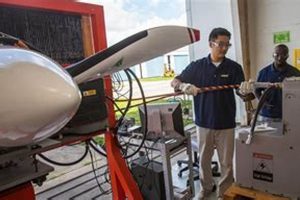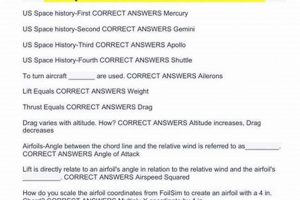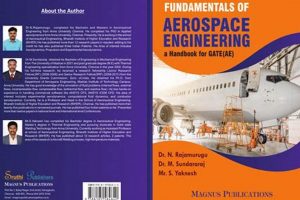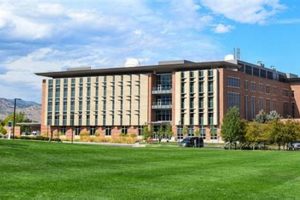The work performed by professionals in this field encompasses a broad spectrum of tasks related to the design, development, testing, and production of aircraft, spacecraft, missiles, and related systems. These activities involve applying principles of physics, mathematics, and engineering to solve complex problems associated with flight within and beyond Earth’s atmosphere. Examples include conducting aerodynamic analyses, designing propulsion systems, overseeing structural integrity, and ensuring compliance with safety regulations.
Competent execution of these tasks is crucial for national security, commercial aviation, and space exploration. Advancements in these areas contribute to economic growth, facilitate global transportation, and expand scientific understanding of the universe. Historically, progress has been driven by a constant need for improved performance, efficiency, and safety, leading to continuous innovation in materials, technologies, and design methodologies.
The following sections will elaborate on specific areas of focus, including design and analysis, testing and validation, systems integration, and regulatory compliance. These areas represent critical components in the lifecycle of aerospace vehicles and demonstrate the breadth of expertise required within the profession.
Guidance for Aspiring Aerospace Engineers
Success in the field is predicated on a combination of theoretical knowledge, practical skills, and professional acumen. The following guidance offers insights into cultivating these attributes.
Tip 1: Strengthen Foundational Knowledge: A robust understanding of mathematics, physics, and computer science is essential. Focus on mastering concepts such as calculus, differential equations, thermodynamics, and fluid dynamics. Solid grounding in these areas provides the basis for tackling complex engineering problems.
Tip 2: Develop Proficiency in Design Software: Familiarity with industry-standard software packages like CAD (Computer-Aided Design), CAM (Computer-Aided Manufacturing), and CAE (Computer-Aided Engineering) is crucial. Practical experience with these tools will enhance efficiency in design, analysis, and simulation tasks.
Tip 3: Cultivate Strong Analytical Skills: Effective problem-solving relies on analytical capabilities. Develop the ability to dissect complex systems into manageable components, identify critical parameters, and analyze their interactions. Quantitative reasoning and data interpretation are vital in this process.
Tip 4: Embrace Continuous Learning: The field is characterized by rapid technological advancements. Commit to lifelong learning by staying abreast of the latest research, publications, and industry trends. Participation in professional development courses and conferences is highly recommended.
Tip 5: Seek Practical Experience: Internships, co-op programs, and research opportunities provide invaluable practical experience. These experiences allow application of theoretical knowledge to real-world engineering challenges and foster collaboration skills.
Tip 6: Enhance Communication Skills: Clear and concise communication is paramount for effective teamwork and project management. Develop both written and oral communication skills to effectively convey technical information to diverse audiences.
Tip 7: Prioritize Ethical Conduct: Adherence to ethical principles is fundamental to maintaining public trust and ensuring the safety and reliability of aerospace systems. Uphold the highest standards of professional integrity and accountability.
In summary, the path to professional competence requires consistent effort in acquiring knowledge, honing skills, and embracing ethical responsibilities. A proactive approach to personal and professional development will be critical for long-term success.
The subsequent sections will delve into specific career paths and areas of specialization within the field.
1. Design and Analysis
Design and analysis are foundational to aerospace engineering. These intertwined processes are crucial for creating safe, efficient, and high-performing aerospace vehicles and systems. The effectiveness of design and analysis directly impacts the success and integrity of all subsequent stages of development, testing, and operation.
- Aerodynamic Performance Analysis
Aerodynamic performance analysis involves studying the interaction between air and aerospace vehicles. This includes calculating lift, drag, and stability characteristics using computational fluid dynamics (CFD) software and wind tunnel testing. For instance, designing a more efficient wing profile for an aircraft to reduce fuel consumption directly contributes to the goals of aerospace engineering.
- Structural Integrity Assessment
Structural integrity assessment focuses on ensuring that aerospace components can withstand the stresses and strains encountered during flight. This includes finite element analysis (FEA) to predict stress concentrations and fatigue life. Analyzing the structural robustness of a spacecraft’s heat shield during atmospheric reentry demonstrates its significance in protecting the payload.
- Propulsion System Design and Analysis
Propulsion system design and analysis involves developing and evaluating engines and other systems that provide thrust for aerospace vehicles. This includes thermodynamic cycle analysis, combustion modeling, and nozzle design. Enhancements in rocket engine efficiency and thrust-to-weight ratio directly benefit space exploration efforts.
- Control Systems Design and Analysis
Control systems design and analysis focuses on creating systems that maintain stability and allow precise maneuvering of aerospace vehicles. This involves designing autopilots, flight control surfaces, and guidance systems. Developing a robust control system for an unmanned aerial vehicle (UAV) is essential for its autonomous operation in complex environments.
The interplay between these facets of design and analysis underscores their pivotal role in all facets of aerospace engineering. Continuous improvements in these areas drive advancements in vehicle performance, safety, and overall system effectiveness, directly aligning with the core responsibilities of the profession.
2. Testing and Validation
Testing and validation are integral components, serving as critical filters in the execution of responsibilities. These processes ensure designs meet specified performance criteria and safety standards. Inadequate testing leads directly to failures in operational environments, highlighting the direct causal link between thorough validation and successful aerospace endeavors. Testing and validation, therefore, mitigate risks and verify the functionality of aerospace systems prior to deployment.
Examples of testing methodologies include wind tunnel testing to validate aerodynamic performance, structural load testing to confirm integrity under stress, and thermal vacuum testing to simulate the extreme conditions of space. Consider the testing of a new aircraft wing design: Wind tunnel tests provide empirical data on lift and drag coefficients, directly influencing design refinements. Similarly, validation of a satellite’s communication system ensures reliable data transmission under operational conditions. These examples show that these activities ensure that engineering specifications translate into real-world operational success.
Comprehensive testing and validation are not merely procedural requirements; they are fundamental to safeguarding lives, protecting investments, and advancing aerospace technology. Challenges such as simulating all conceivable operational scenarios and managing the costs associated with extensive testing persist, but these difficulties do not diminish the core importance of validation within aerospace engineering. Without rigorous testing and validation, the advancement of aerospace technologies and the fulfillment of engineering objectives would be severely compromised, posing unacceptable risks to all stakeholders.
3. Systems Integration
Systems integration is a pivotal aspect of aerospace engineering, demanding that diverse components function cohesively. This process necessitates the harmonizing of mechanical, electrical, and software elements to achieve mission objectives. Its success directly influences the effectiveness and reliability of aerospace vehicles and systems, embodying a critical responsibility for engineers.
- Avionics Integration
Avionics integration involves the seamless merging of navigation, communication, and control systems. For example, integrating a flight management system with autopilot and radar sensors ensures precise navigation and collision avoidance, directly impacting flight safety and efficiency. The task presents challenges due to the need for compatibility across various hardware and software platforms, requiring meticulous planning and testing.
- Propulsion System Integration
Propulsion system integration centers on incorporating engines or rocket motors into airframes or spacecraft structures. This requires careful consideration of factors such as thrust alignment, vibration isolation, and thermal management. Integrating a new rocket engine into a launch vehicle necessitates extensive analysis and testing to ensure stable and efficient operation throughout the flight profile.
- Payload Integration
Payload integration involves incorporating mission-specific instruments or equipment into aerospace vehicles. This encompasses physical mounting, electrical power distribution, data handling, and environmental control. Installing a scientific instrument on a satellite requires precise alignment, thermal insulation, and data interface compatibility to ensure accurate data collection in space.
- Human-Machine Interface (HMI) Integration
HMI integration focuses on creating effective interfaces between human operators and aerospace systems. This requires designing intuitive controls, displays, and feedback mechanisms. Integrating a heads-up display (HUD) into a fighter aircraft requires optimizing the presentation of critical flight information to minimize pilot workload and enhance situational awareness.
The listed facets illustrate the breadth and depth of systems integration within aerospace engineering. From avionics to HMIs, the successful integration of these components directly impacts system performance, reliability, and safety. The responsible execution of systems integration ensures that complex aerospace vehicles operate as intended, meeting stringent mission requirements.
4. Regulatory Compliance
Regulatory compliance forms an indispensable element within aerospace engineering, ensuring that all designs, operations, and maintenance activities adhere to stringent safety and performance standards mandated by governmental and industry bodies. This adherence is non-negotiable, influencing every stage of a project lifecycle and reflecting the profession’s commitment to public safety and operational integrity.
- Airworthiness Certification
Airworthiness certification involves demonstrating that an aircraft design meets specific safety criteria established by regulatory agencies such as the Federal Aviation Administration (FAA) or the European Union Aviation Safety Agency (EASA). This process includes rigorous testing, documentation, and analysis to ensure the aircraft can be operated safely under defined conditions. The consequences of non-compliance can range from costly design modifications to operational restrictions or even grounding of the aircraft fleet, emphasizing the critical nature of meeting certification requirements.
- Environmental Regulations
Environmental regulations impose limits on noise emissions and pollutant discharges from aircraft operations. Aerospace engineers must design engines and airframes to minimize environmental impact, complying with standards set by organizations like the International Civil Aviation Organization (ICAO). Failure to comply with these regulations can result in fines, operational limitations, and damage to an organization’s reputation, underscoring the increasing importance of sustainable design practices.
- Safety Management Systems (SMS)
Safety Management Systems (SMS) are structured approaches to managing safety risks within aerospace organizations. Regulatory compliance mandates the implementation of SMS programs to identify hazards, assess risks, and implement controls to prevent accidents and incidents. These systems require continuous monitoring, reporting, and improvement to maintain a high level of safety across all operations. Non-compliance with SMS requirements can expose organizations to increased liability and regulatory scrutiny.
- Export Control Regulations
Export control regulations govern the transfer of aerospace technology and equipment to foreign entities. Aerospace engineers must comply with regulations such as the International Traffic in Arms Regulations (ITAR) in the United States to prevent sensitive technologies from falling into the wrong hands. Violations of export control regulations can result in severe penalties, including fines, imprisonment, and loss of export privileges, highlighting the importance of vigilance and adherence to international laws.
The multifaceted nature of regulatory compliance extends beyond mere adherence to rules; it requires a proactive and integrated approach to ensure that safety, environmental, and security considerations are embedded within every facet of aerospace engineering practice. The commitment to regulatory compliance exemplifies the profession’s dedication to public welfare and responsible technological advancement.
5. Research & Development
Research & Development (R&D) forms a critical component of the duties inherent to aerospace engineering. It serves as the engine of innovation, propelling the field forward through the exploration of new concepts, materials, and technologies. The activities undertaken in R&D directly influence the capabilities, efficiency, and safety of future aerospace vehicles and systems. As such, a commitment to R&D is fundamental to the ongoing advancement of the profession.
- Advanced Materials Research
This facet focuses on investigating and developing new materials with enhanced properties such as strength, weight, and temperature resistance. Examples include the creation of advanced composites for lighter aircraft structures or high-temperature alloys for more efficient engines. This directly impacts aerospace engineering by enabling the design of more capable and efficient vehicles. For example, the development of carbon fiber composites allows for lighter, stronger aircraft that consume less fuel.
- Novel Propulsion Systems
This area concerns the exploration of innovative propulsion concepts beyond traditional rocket engines, such as hypersonic propulsion, electric propulsion, and fusion propulsion. The development of these systems aims to enable faster and more efficient space travel. Research into scramjet technology, for instance, could revolutionize hypersonic flight, dramatically reducing travel times and expanding access to space. This research directly influences the responsibilities of aerospace engineers involved in designing future aircraft and spacecraft.
- Autonomous Systems Development
This facet focuses on creating intelligent systems capable of operating independently with minimal human intervention. This includes developing algorithms for autonomous navigation, collision avoidance, and mission planning. The development of autonomous drones for surveillance or delivery purposes illustrates the practical applications of this research. This area directly impacts aerospace engineering by enabling the design of unmanned aerial vehicles (UAVs) for diverse applications, reducing risks to human operators and improving operational efficiency.
- Aerodynamic Efficiency Enhancement
This research area involves improving the aerodynamic performance of aerospace vehicles through innovative design techniques and flow control technologies. Examples include the development of winglets, vortex generators, and active flow control systems. This has a direct impact on reducing drag, increasing lift, and improving fuel efficiency. Research into laminar flow control, for instance, could significantly reduce aircraft drag, resulting in substantial fuel savings and reduced emissions. Such advancements directly influence the work of aerospace engineers tasked with designing more fuel-efficient and environmentally friendly aircraft.
The aforementioned facets of R&D demonstrate its integral connection to the duties and responsibilities inherent to aerospace engineering. They not only drive innovation but also enable the development of safer, more efficient, and more capable aerospace systems. The continued pursuit of research and development is, therefore, essential for the sustained progress of the field and its contribution to society.
Frequently Asked Questions
The following questions address common inquiries concerning the scope and nature of activities in this profession.
Question 1: What are the primary areas of focus for professionals in this field?
The core focus encompasses design and analysis, testing and validation, systems integration, regulatory compliance, and research and development. These areas represent fundamental aspects of the lifecycle for aerospace vehicles.
Question 2: How does aerodynamic performance analysis contribute to the overall responsibilities?
Aerodynamic performance analysis directly influences aircraft and spacecraft design, impacting fuel efficiency, stability, and overall performance. This analysis ensures vehicles can operate safely and effectively within their intended environments.
Question 3: Why is testing and validation such a critical component of aerospace engineering?
Testing and validation serves as the process of mitigating potential risks and ensuring designs align with specified criteria, contributing to the success and integrity of aerospace endeavors. Thorough validation is essential before deployment.
Question 4: In what ways does systems integration impact the functionality of aerospace systems?
Systems integration ensures that mechanical, electrical, and software components function cohesively, achieving mission objectives. Proper integration is crucial for the reliability and effectiveness of aerospace vehicles.
Question 5: Why is adherence to regulatory compliance important, and what does it entail?
Regulatory compliance ensures designs, operations, and maintenance align with safety and performance standards, reflecting a commitment to public safety and operational integrity. These standards are mandated by regulatory bodies.
Question 6: How does research and development influence the future of aerospace engineering?
Research and development propels innovation through the exploration of new concepts, materials, and technologies. It enhances the capabilities, efficiency, and safety of future aerospace vehicles and systems.
These FAQs highlight essential aspects, emphasizing the responsibilities and their significance within the field.
The subsequent segments will elaborate on diverse career trajectories and specialized domains within the aerospace profession.
Aerospace Engineering
This exploration has elucidated the multifaceted nature of aerospace engineering duties and responsibilities. From the initial stages of design and analysis through rigorous testing and validation, the profession demands a commitment to excellence and precision. Systems integration ensures seamless functionality, while unwavering adherence to regulatory compliance safeguards public welfare. Research and development acts as the catalyst for innovation, continually pushing the boundaries of what is achievable. These core activities represent the fundamental essence of the profession.
The ongoing pursuit of advancements within aerospace technology necessitates a dedication to both theoretical understanding and practical application. As the field continues to evolve, the aerospace engineering duties and responsibilities will remain integral to ensuring the safety, efficiency, and progress of air and space travel. The challenges are significant, but the potential rewards in terms of scientific discovery and technological innovation are immeasurable. Therefore, those entering this field should be prepared to embrace both the complexity and the profound impact of their contributions.







